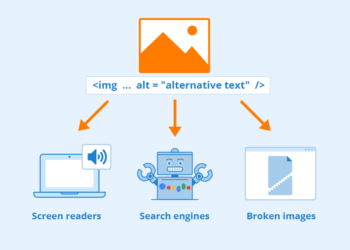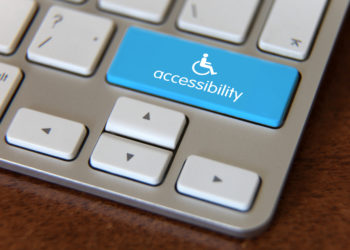Editor’s note: Today’s post is by Lettie Conrad, Caroline Desrosiers, Hannah Heckner, and Michelle Urberg. Caroline is the Founder & CEO of Scribely, a company on a mission to make images and videos more accessible to blind and visually impaired people and more discoverable to search engines. Hannah serves as Vice President of Product at Silverchair. Michelle is SaaS Implementation Manager /Metadata Consultant and Librarian with EBSCO Information Services, and an independent consultant specializing in metadata and discovery enhancement.
When it comes to delivering accessible scholarly publications — specifically, those with equal access to collections of images or the graphics that appear in books and journals — we are working with a complex network of shared responsibilities. The Justice Department’s recently updated guidelines on web compliance with the Americans with Disabilities Act (ADA) are a good demonstration of how each player in the content supply chain, from authors to producers to distributors, must do their part to make images within scholarly publications accessible to everyone. As our friend Todd Carpenter pointed out last week, alternative text (alt text) for images is becoming a critical component of the high-value content produced by scholarly publishers.
The scholarly communications supply chain is not alone, as content and service providers of all kinds are adapting workflows to enrich image metadata and deliver on accessibility requirements. Companies like Google, Twitter, and Microsoft, among hundreds of others, acknowledge that accessibility and inclusive publishing practices are part of doing business in today’s digital information economy (and mitigate legal liabilities). In addition to leveling the playing field for disabled readers, accessible images offer all users an improved experience — from better search and faster navigation, to enriching audio experiences for those using text-to-speech assistive technologies.

In our panel at the 2022 Society for Scholarly Publishing Annual Meeting, we discussed the many opportunities available to today’s content providers who are committed to delivering an inclusive reading experience, and who wish to unlock the numerous benefits of data-rich accessible images. This post highlights the session takeaways and practical solutions we recommend for ensuring scholarly image collections and in-line graphics are fully accessible to all authorized readers.
Good metadata, doing good
A majority of the underlying standards that govern digital content markup define what is expected of fully accessible publications, including image files and in-line graphics. For those of us providing content to academic and special libraries, metadata is our calling card to attract user attention. Our institutional customers are – rightly – increasingly demanding accessibility improvements for publisher platforms and in the metadata we send to them. As accessibility guru Bill Kasdorf pointed out, publishers have all the tools necessary to distribute data-rich images and born-accessible publications to all of their customers, including libraries.
The must-know standards checklist for accessible scholarly publishing includes:
- The Web Content Accessibility Guidelines (WCAG) require text alternatives (alt text) for all meaningful images.
- The photo metadata standards from the IPTC (International Press Telecommunications Council) now include embedded alt text to be used across digital ecosystems.
- The Onix Codelist 196 tags offer short and full alt text tags for books.
- Schema.org tagging provides specific fields to describe how content is made accessible.
- The Journal Article Tagging Suite (JATS) offers tagging for long and short descriptions, as well as uniform resource identifier (URI) tags for linking to more comprehensive descriptions.
- MARC supports accessibility metadata, such as the availability of alt text or other accessibility features (field 341 and field 532).
- EPUB, now in 3.3 allows ebooks to be shared in a single, accessibility-compliant container.
The supply-chain infrastructure enabled by these standards and schemas allows content providers to automate content and metadata transfer; however, in order to distribute scholarly content with robust alt-text metadata, the production pipeline requires an expert human touch (especially by authors and editors at the beginning of the pipeline). Once the alt text is created, in other words, economies of scale can be found in automating quality assurance and delivery of the content metadata fed through the information pipelines that connect our industry. Take the time to create the alt text and design an XML workflow that human-scales your digital publishing process.
The power of the platform
Shared platform infrastructure introduces further opportunities for scaling accessible publishing solutions, from the front-end ‘face’ of the content presented to both human and machine readers, to back-end content management and distribution systems. Our platform partners can help audit the accessibility of images on our sites and develop plans to optimize access to the graphics and tables within research papers; logos and other branding assets; access or ecommerce indicators; and image collections.
Looking to Silverchair as an example, we know that the origination, use, and authorship of those images is also multifaceted. Just as these workflows are multifaceted, so too are the solution pathways for content providers and their platforms to create and deliver the most accessible images possible. While some commonly held practices fall short of the ideal state of accessibility, i.e., automatically placing image captions into alt text fields if not otherwise provided, platform partners can be effective partners in helping to institute and enforce best practices across multiple sites. Content specifications can create spaces to insert alt text in xml, backend tooling can prompt users to include alt text whenever images are uploaded, and end-user feedback can be funneled into future developments.
Ultimately, accessible images are a shared responsibility – which means we need to avoid hot-potato blame games and instead leverage methods that harness shared objectives and collective benefits. We can develop feedback loops and collaborative efforts to refine how accessible publishing works in our industry. Together, we can act proactively, rather than reactively, when budgeting our investments in digital information experiences.
Accessible images, born accessible
Digitally inclusive images are the most time- and cost-efficient when part of a born-accessible publishing workflow. It is ideal to capture authors’ intended meanings for in-line images as far upstream from the point of publication — as the cost and effort to remediate inaccessible published images can be prohibitively high for most organizations. Publishing staff who support authors and editors in their content design and development process can integrate alt text as part of their standard workflows for journals, books, and image collections.
Good alt text captures the context and subtext expressed by tables, photographs, and other images in scholarly publications, serving both accessibility and archival purposes. While automated descriptions are coming into everyday software programs like MS Word and Powerpoint, only human authors can adequately apply the sort of critical thinking, empathy, and expertise needed to generate rich, descriptive text for the graphics in our content products. Extended descriptions are required for more complex or highly detailed images. In this case, the alt text should identify the purpose of the image with further details provided in the extended description. Check out the W3C page on Complex Images for tips on how to best approach extended descriptions.
Once alt text workflows are in place, publishers can organize those assets in a central content repository for adaptation and distribution. Routine evaluation of accessible publishing practices can help ensure providers are up to speed with the latest industry expectations for image metadata supported by the scholarly information channels popular with our users.
Aligning our values
When scholarly images are consumable by readers of all types, content providers align our industry values of equity and inclusiveness with our publishing practices. Accessible publishing is about reaching the entirety of your audience, cultivating user delight, and serving as good stewards of the content we distribute. Accessible images also feed rich assets into data-driven products and services, and improve content discoverability. Even where image metadata may not yet be usable by library discovery services or other institutional channels, many accessibility standards are reflected in best practices for mainstream search engine optimization. Moreover, the more alt text available, the more likely platform providers will be to update their systems to accommodate image alt text.
Access to information is a human right. According to the social model of disability, it is the momentum of the status quo that, ultimately, disables people. We have the power to make physical and virtual places more accessible, and to eliminate the barriers that place people at a disadvantage. Alt text is one powerful way we can eliminate barriers to work and education. When publishers neglect to do this, millions of blind and visually impaired people are disabled from equal participation in work and education — which runs counter to the mission of pretty much any scholarly publisher out there!
Next steps
- Enlist subject experts — ideally authors — to ensure in-line graphics and image collections include rich descriptive metadata.
- Pivot to inclusive design practices, where the disabled reader experience is an integral part of product design and content development.
- Institute best practices and relevant data standards that encourage and incentivize creating and distributing images with rich descriptions.
- Get a seat at the table in WCAG and other standards groups. This is a key way to both learn about and influence the creation of standards governance, as well as to establish a productive network of colleagues across the supply chain.
- Engage with your disabled readers, customers, authors, and other stakeholders; it is critical to seek direct feedback from disabled users.

Discussion
1 Thought on "An Action Plan for Accessible Images: Practical Solutions for Publishers, Platforms, and Providers"
I have two questions around accessible images:
1. To extent are figure legends sufficient? I can imagine an author being asked to write alt text for their graphs and thinking, “Didn’t I just submit 150 words describing this?”
2. While the tools are in place for XML and epub, they’re less well developed for LaTeX. So if you’re using Overleaf you can find workarounds but nothing equivalent to inputting alt text via paid Acrobat software. Surely it would be trivial for some accessibility champion to pay some LaTeX developers to incorporate alt text into the most widely used graphics packages?



